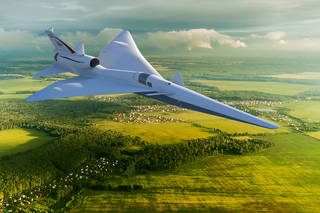NASA has successfully tested an advanced air-to-air photographic technology in flight, utilizing a NASA B-200 King Air to capture the first-ever images of the interaction of shockwaves from two supersonic aircraft in flight.
“I am ecstatic about how these images turned out,” said J.T. Heineck, a Physical Scientist at NASA’s Ames Research Center in California’s Silicon Valley. “With this upgraded system, we have, by an order of magnitude, improved both the speed and quality of our imagery from previous research.”
The images were captured during the fourth phase of Air-to-Air Background Oriented Schlieren flights, or AirBOS, which took place at NASA’s Armstrong Flight Research Center in Edwards, California. The flight series saw successful testing of an upgraded imaging system capable of capturing high-quality images of shockwaves.
The system will be used to capture data crucial to confirming the design of the agency’s X-59 Quiet SuperSonic Technology X-plane, or X-59 QueSST, which will fly supersonic, but will produce shockwaves in such a way that, instead of a loud sonic boom, only a quiet rumble may be heard. The ability to fly supersonic without a sonic boom may one day result in lifting current restrictions on supersonic flight over land.

The images feature a pair of T-38s from the U.S. Air Force Test Pilot School at Edwards Air Force Base, flying in formation at supersonic speeds. The T-38s are flying approximately 30 feet away from each other, with the trailing aircraft flying about 10 feet lower than the leading T-38. With exceptional clarity, the flow of the shock waves from both aircraft is seen, and for the first time, the interaction of the shocks can be seen in flight.

“We’re seeing a level of physical detail here that I don’t think anybody has ever seen before,” said Dan Banks, senior research engineer at NASA Armstrong. “Just looking at the data for the first time, I think things worked out better than we’d imagined. This is a very big step.”
The images were captured from a NASA B-200 King Air, using an upgraded camera system to increase image quality. The upgraded system included the addition of a camera able to capture data with a wider field of view. This improved spatial awareness allowed for more accurate positioning of the aircraft. The system also included a memory upgrade for the cameras, permitting researchers to increase the frame rate to 1400 frames per second, making it easier to capture a larger number of samples. Finally, the system received an upgraded connection to data storage computers, which allowed for a much higher rate of data download. This also contributed to the team being able to capture more data per pass, boosting the quality of the images.
In addition to a recent avionics upgrade for the King Air, which improved the ability of the aircraft to be in the exact right place at the exact right time, the team also developed a new installation system for the cameras, drastically reducing the time it took to integrate them with the aircraft.
“With previous iterations of AirBOS, it took up to a week or more to integrate the camera system onto the aircraft and get it working. This time we were able to get it in and functioning within a day,” said Tiffany Titus, flight operations engineer. “That’s time the research team can use to go out and fly, and get that data.”
While the updated camera system and avionics upgrade on the B-200 greatly improved the ability to conduct these flights more efficiently than in previous series, obtaining the images still required a great deal of skill and coordination from engineers, mission controllers, and pilots from both NASA and Edwards’ U.S. Air Force Test Pilot School.
In order to capture these images, the King Air, flying a pattern around 30,000 feet, had to arrive in a precise position as the pair of T-38s passed at supersonic speeds approximately 2,000 feet below. Meanwhile, the cameras, able to record for a total of three seconds, had to begin recording at the exact moment the supersonic T-38s came into frame.
“The biggest challenge was trying to get the timing correct to make sure we could get these images,” said Heather Maliska, AirBOS sub-project manager. “I’m absolutely happy with how the team was able to pull this off. Our operations team has done this type of maneuver before. They know how to get the maneuver lined up, and our NASA pilots and the Air Force pilots did a great job being where they needed to be.”
The data from the AirBOS flights will continue to undergo analysis, helping NASA refine the techniques for these tests to improve data further, with future flights potentially taking place at higher altitudes. These efforts will help advance knowledge of the characteristics of shockwaves as NASA progresses toward quiet supersonic research flights with the X-59, and closer toward a major milestone in aviation.
Press Release by NASA

